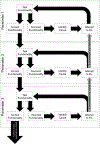Validating Human-Operant Software: A Case Example
- PMID: 36467429
- PMCID: PMC9718443
- DOI: 10.1037/bar0000244
Validating Human-Operant Software: A Case Example
Abstract
Human-operant experiments conducted with computer software facilitate translational research by assessing the generality of basic research findings and exploring previously untested predictions about behavior in a cost-effective and efficient manner. However, previous human-operant research with computer-based tasks has included little or no description of rigorous validation procedures for the experimental apparatus (i.e., the software used in the experiment). This omission, combined with a general lack of guidance regarding how to thoroughly validate experimental software, introduces the possibility that nascent researchers may insufficiently validate their computer-based apparatus. In this paper, we provide a case example to demonstrate the rigor required to validate experimental software by describing the procedures we used to validate the apparatus reported by Smith and Greer (2021) to assess relapse via a crowdsourcing platform. The validation procedures identified several issues with early iterations of the software, demonstrating how failing to validate human-operant software can introduce confounds into similar experiments. We describe our validation procedures in detail so that others exploring similar computer-based research may have an exemplar for the rigorous testing needed to validate computer software to ensure precision and reliability in computer-based, human-operant experiments.
Keywords: apparatus validation; computer software; human operant; translational research.
Figures
Similar articles
-
Recording human electrocorticographic (ECoG) signals for neuroscientific research and real-time functional cortical mapping.J Vis Exp. 2012 Jun 26;(64):3993. doi: 10.3791/3993. J Vis Exp. 2012. PMID: 22782131 Free PMC article.
-
A low-cost touchscreen operant chamber using a Raspberry Pi™.Behav Res Methods. 2018 Dec;50(6):2523-2530. doi: 10.3758/s13428-018-1030-y. Behav Res Methods. 2018. PMID: 29520633
-
Evaluating the presence versus absence of the reinforcer during extinction.J Appl Behav Anal. 2014 Fall;47(3):617-22. doi: 10.1002/jaba.131. Epub 2014 May 12. J Appl Behav Anal. 2014. PMID: 24817521
-
Translational cognitive neuroscience of dementia with touchscreen operant chambers.Genes Brain Behav. 2021 Jan;20(1):e12664. doi: 10.1111/gbb.12664. Epub 2020 Aug 18. Genes Brain Behav. 2021. PMID: 32374080 Review.
-
Software for designing rigorous and replicable preclinical research: The Experimental Design Accelerator.J Neurosci Res. 2019 Sep;97(9):1043-1050. doi: 10.1002/jnr.24440. Epub 2019 May 29. J Neurosci Res. 2019. PMID: 31144358 Review.
Cited by
-
Translational evaluation of on/off alternative reinforcement cycling.J Exp Anal Behav. 2023 Nov;120(3):429-439. doi: 10.1002/jeab.879. Epub 2023 Sep 7. J Exp Anal Behav. 2023. PMID: 37680018 Free PMC article.
References
-
- Jarmolowicz DP, & Lattal KA (2014). Resurgence under delayed reinforcement. The Psychological Record, 64(2), 189–193. 10.1007/s40732-014-0040-0 - DOI
-
- Kuroda T, Ritchey CM, & Podlesnik CA (2021, May). A tutorial for developing customizable systems for conducting operant experiments online with Amazon Mechanical Turk. ResearchGate. https://www.researchgate.net/publication/351942398_A_Tutorial_for_Develo...
Grants and funding
LinkOut - more resources
Full Text Sources


